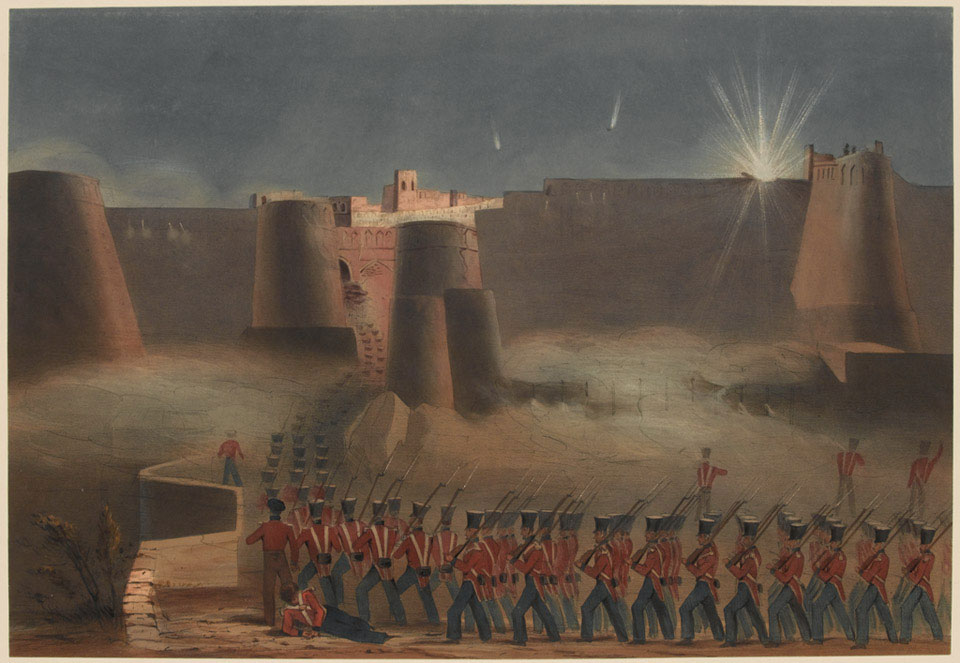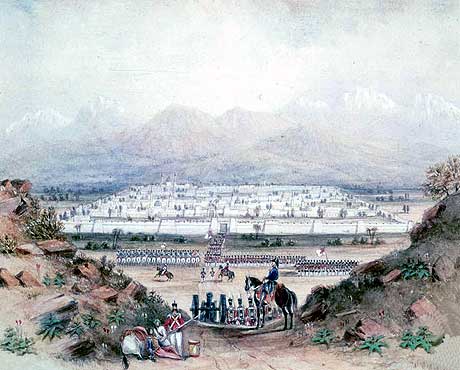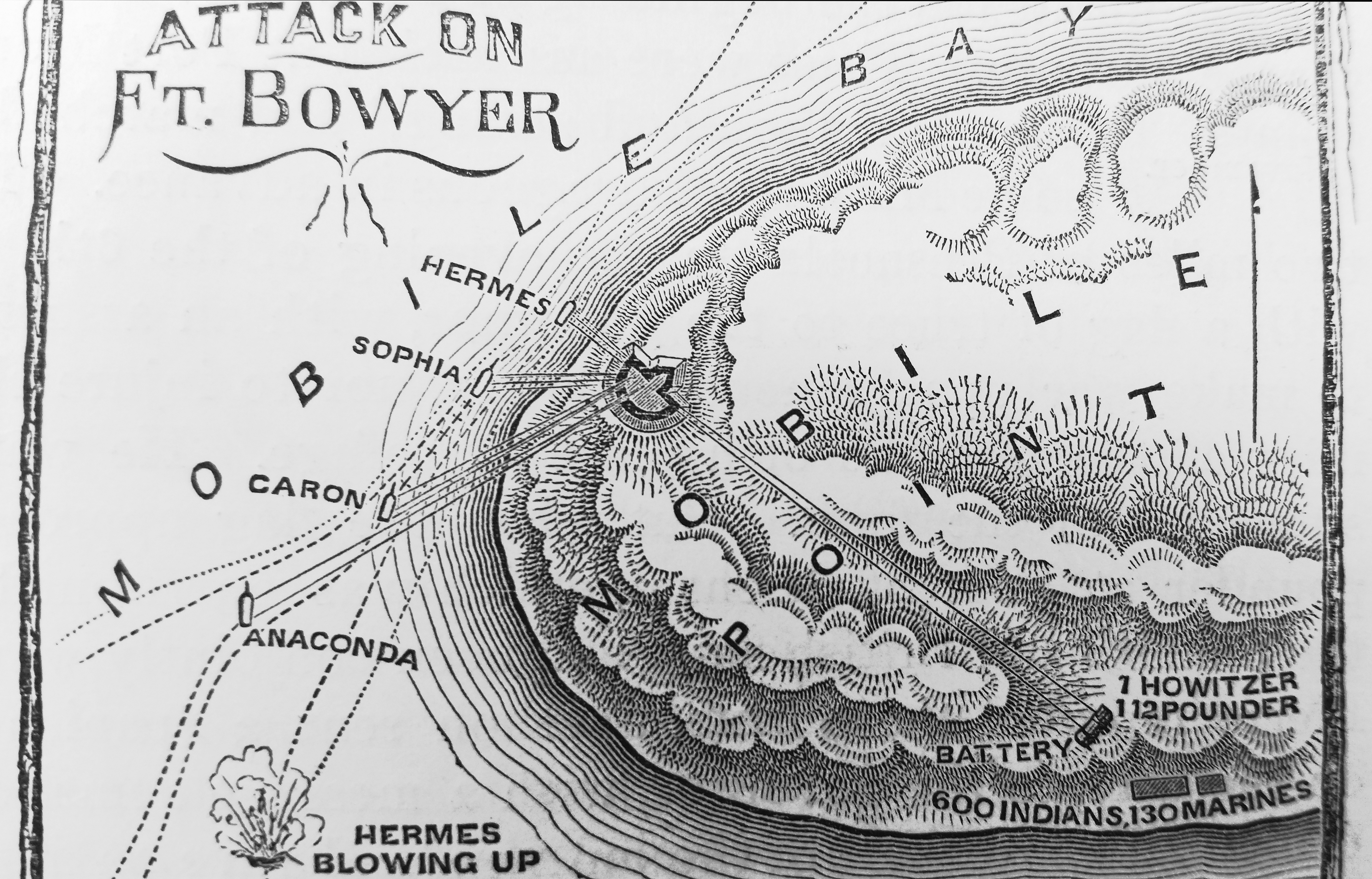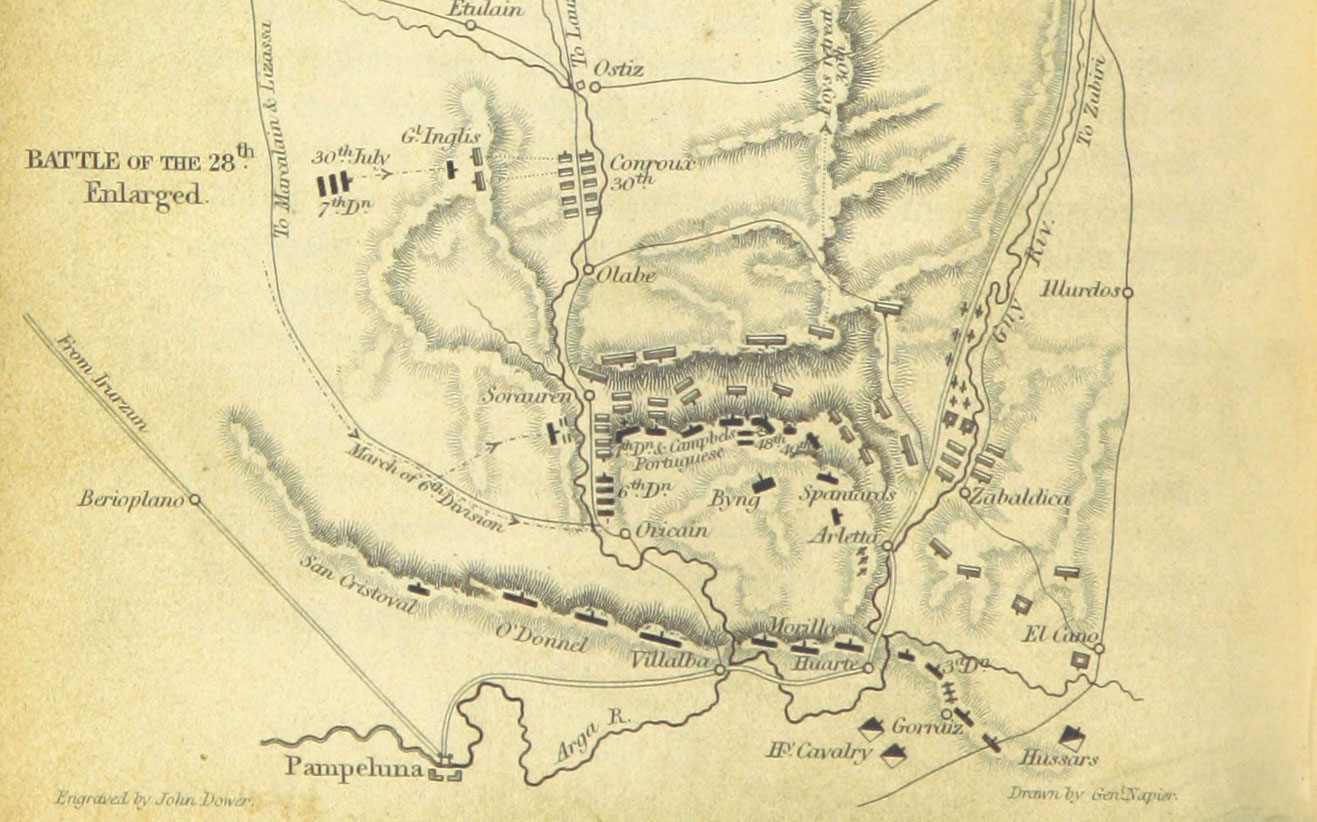|
John Keane, 1st Baron Keane
Lieutenant-General John Keane, 1st Baron Keane (6 February 1781 – 24 August 1844) was an Irish soldier, whose military exploits in the First Anglo-Afghan War led to him being created Baron Keane of Ghuznee. Early life John Keane was born in Waterford, Ireland, on 6 February 1781; he was the second son of John Keane of Cappoquin, and his wife Sarah Kelly. Keane's father would be created the Keane baronet in 1801. He was the younger brother of the future Lt.-Col. Sir Richard Keane, 2nd Baronet and the elder of Col. Edward Keane. Military service French Revolutionary Wars While there is some confusion as to when this occurred, Keane most likely joined the British Army on 11 October 1794, becoming an ensign in the 122nd Regiment of Foot. He was quickly promoted, becoming a lieutenant on 30 October. With the speed of Keane's promotions, it is likely that he never actually reported for duty with the 122nd. His father then purchased his promotion to captain in the 124th Regi ... [...More Info...] [...Related Items...] OR: [Wikipedia] [Google] [Baidu] |
Lieutenant General (United Kingdom)
Lieutenant general (Lt Gen), formerly more commonly lieutenant-general, is a senior rank in the British Army and the Royal Marines. It is the equivalent of a multinational three-star rank; some British lieutenant generals sometimes wear three-star insignia, in addition to their standard insignia, when on multinational operations. Lieutenant general is a superior rank to Major-general (United Kingdom), major general, but subordinate to a General (United Kingdom), (full) general. The rank has a NATO rank code of OF-8, equivalent to a Vice-Admiral (Royal Navy), vice-admiral in the Royal Navy and an air marshal in the Royal Air Force (RAF) and the air forces of many Commonwealth of Nations, Commonwealth countries. The rank insignia for both the Army and the Royal Marines is a crown over a crossed sabre and baton. During the reign of Elizabeth II, the St Edward's Crown, commonly known as the Queen's Crown, was depicted. Before 1953, and again since the accession of Charles III in 20 ... [...More Info...] [...Related Items...] OR: [Wikipedia] [Google] [Baidu] |
Battle Of Alexandria (1801)
The Battle of Alexandria (also known as the Battle of Canope) fought on 21 March 1801 between the British and French armies as part of the French invasion of Egypt and Syria. Led by General Sir Ralph Abercromby, the British engaged a French force under Divisional-general Jacques-François Menou near the ruins of Nicopolis, on the narrow spit of land between the Mediterranean Sea and Abukir. The British routed Menou's army after several hours of fierce fighting, though Abercromby was mortally wounded. John Hely-Hutchinson, who replaced Abercromby, led the British army to Alexandria and laid siege to the city, which surrendered in September. Background Following Lanusse's reverse at Mandora, Menou finally arrived from Cairo to take direct command of French forces, and determined to attack on 21 March. François Lanusse would lead on the left with the brigades of Valentin and Silly, supported by the infantry Divisions of Antoine-Guillaume Rampon in the centre and Jean Reynier ... [...More Info...] [...Related Items...] OR: [Wikipedia] [Google] [Baidu] |
First Afghan War
The First Anglo-Afghan War () was fought between the British Empire and the Emirate of Kabul from 1838 to 1842. The British initially successfully invaded the country taking sides in a succession dispute between emir Dost Mohammad Khan ( Barakzai) and former King Shah Shujah (Durrani), whom they reinstalled upon occupying Kabul in August 1839. The main British Indian force occupied Kabul and endured harsh winters. The force and its camp followers were almost completely massacred during the 1842 retreat from Kabul. The British then sent what was widely termed an " Army of Retribution" to Kabul to avenge the destruction of the previous forces. After recovering prisoners, they left Afghanistan by the end of the year. Dost Mohammed returned from exile in India to resume his rule. It was one of the first major conflicts during the Great Game, the 19th century competition for power and influence in Central Asia between Britain and Russia. Background Causes The 19th century wa ... [...More Info...] [...Related Items...] OR: [Wikipedia] [Google] [Baidu] |
Fort Bowyer
Fort Bowyer was a short-lived earthen and stockade fortification that the United States Army erected in 1813 on Mobile Point, near the mouth of Mobile Bay in what is now Baldwin County, Alabama, but then was part of the Mississippi Territory. The British twice attacked the fort during the War of 1812. The first attack took place in September 1814; unsuccessful, it led to the British changing their strategy and attacking New Orleans. The second attack, following the Battle of New Orleans, was successful. It took place in February 1815, after the Treaty of Ghent had been signed but before the news had reached that part of America. Between 1819 and 1834 the United States built a new masonry fortification, Fort Morgan, on the site of Fort Bowyer. Construction Mobile had been a Spanish possession before the beginning of the Patriot War, but Congress had declared it American territory after the War of 1812 started. After Spanish forces evacuated Mobile in April 1813, the Americans ... [...More Info...] [...Related Items...] OR: [Wikipedia] [Google] [Baidu] |
Battle Of New Orleans
The Battle of New Orleans was fought on January 8, 1815, between the British Army under Major General Sir Edward Pakenham and the United States Army under Brevet Major General Andrew Jackson, roughly 5 miles (8 km) southeast of the French Quarter of New Orleans, in the current suburb of Chalmette, Louisiana. The battle was the climax of the five-month War of 1812#Gulf of Mexico Coast, Gulf Campaign (September 1814 to February 1815) by Britain to try to take New Orleans, West Florida, and possibly Louisiana Territory which began at the Fort Bowyer#First battle, First Battle of Fort Bowyer. Britain started the New Orleans campaign on December 14, 1814, at the Battle of Lake Borgne and numerous skirmishes and artillery duels happened in the weeks leading up to the final battle. The battle took place 15 days after the signing of the Treaty of Ghent, which formally ended the War of 1812, on December 24, 1814, though it would not be ratified by the United States (and therefor ... [...More Info...] [...Related Items...] OR: [Wikipedia] [Google] [Baidu] |
War Of 1812
The War of 1812 was fought by the United States and its allies against the United Kingdom of Great Britain and Ireland, United Kingdom and its allies in North America. It began when the United States United States declaration of war on the United Kingdom, declared war on Britain on 18 June 1812. Although peace terms were agreed upon in the December 1814 Treaty of Ghent, the war did not officially end until the peace treaty was ratified by the 13th United States Congress, United States Congress on 17 February 1815. AngloAmerican tensions stemmed from long-standing differences over territorial expansion in North America and British support for Tecumseh's confederacy, which resisted U.S. colonial settlement in the Old Northwest. In 1807, these tensions escalated after the Royal Navy began enforcing Orders in Council (1807), tighter restrictions on American trade with First French Empire, France and Impressment, impressed sailors who were originally British subjects, even those who ... [...More Info...] [...Related Items...] OR: [Wikipedia] [Google] [Baidu] |
Battle Of Toulouse (1814)
A battle is an occurrence of combat in warfare between opposing military units of any number or size. A war usually consists of multiple battles. In general, a battle is a military engagement that is well defined in duration, area, and force commitment. An engagement with only limited commitment between the forces and without decisive results is sometimes called a skirmish. The word "battle" can also be used infrequently to refer to an entire operational campaign, although this usage greatly diverges from its conventional or customary meaning. Generally, the word "battle" is used for such campaigns if referring to a protracted combat encounter in which either one or both of the combatants had the same methods, resources, and strategic objectives throughout the encounter. Some prominent examples of this would be the Battle of the Atlantic, Battle of Britain, and the Battle of France, all in World War II. Wars and military campaigns are guided by military strategy, wh ... [...More Info...] [...Related Items...] OR: [Wikipedia] [Google] [Baidu] |
Battle Of Orthes
The Battle of Orthez (27 February 1814) saw the Anglo-Spanish-Portuguese Army under Field Marshal Arthur Wellesley, 1st Duke of Wellington, Arthur Wellesley, Marquess of Wellington attack an First French Empire, Imperial French army led by Marshal Nicolas Jean de Dieu Soult, Nicolas Soult in southern France. The outnumbered French repelled several Allied assaults on their right flank, but their center and left flank were overcome and Soult was compelled to retreat. At first the withdrawal was conducted in good order, but it eventually ended in a scramble for safety and many French soldiers became prisoners. The engagement occurred near the end of the Peninsular War. In mid-February, Wellington's army broke out of its small area of conquered territory near Bayonne. Moving east, the Allies drove the French back from several river lines. After a pause in the campaign, the westernmost Allied corps surrounded and isolated Bayonne. Resuming their eastward drive, the remaining two ... [...More Info...] [...Related Items...] OR: [Wikipedia] [Google] [Baidu] |
Battle Of Nivelle
The Battle of Nivelle (10 November 1813) took place in front of the river Nivelle near the end of the Peninsular War (1808–1814). After the Allied siege of San Sebastian, Wellington's 80,000 British, Portuguese and Spanish troops (20,000 of the Spaniards were untried in battle) were in hot pursuit of Marshal Soult who had 60,000 men to place in a 20-mile perimeter. After the Light Division, the main British army was ordered to attack and the 3rd Division split Soult's army in two. By two o'clock, Soult was in retreat and the British in a strong offensive position. Soult had lost another battle on French soil and had lost 4,500 men to Wellington's 5,500. Background In the Siege of San Sebastian, the Anglo-Portuguese stormed and captured the port at the beginning of September 1813. In the Battle of San Marcial on 31 August, Soult failed to break through the Spanish defences in his final attempt to relieve the siege. The French army then fell back to defend the Bid ... [...More Info...] [...Related Items...] OR: [Wikipedia] [Google] [Baidu] |
Battle Of Sorauren
The Battle of Sorauren was part of a series of engagements in late July 1813 called the Battle of the Pyrenees in which a combined British and Portuguese force under Sir Arthur Wellesley held off Marshal Soult's French forces attempting to relieve Pamplona. Prelude With sizable Anglo-Portuguese forces tied up in assaulting San Sebastián and besieging Pamplona, the new French commander Marshal Soult launched a counterattack with the ''Armée d'Espagne'' through Maya and Roncesvalles. Although the French initially enjoyed local superiority, the tough terrain combined with stubborn British and Portuguese resistance slowed the French advance to a crawl. Battle The main French column of about 40,000 men under Clausel and Reille marched to attack Sorauren. On the 27July the heavily outnumbered British forces there were drawn up on the Oricain Ridge. Wellesley made a dramatic ride along the ridge in front of the cheering British and Portuguese troops and Soult postponed ... [...More Info...] [...Related Items...] OR: [Wikipedia] [Google] [Baidu] |
Battle Of Vitoria
At the Battle of Vitoria (21 June 1813), a United Kingdom of Great Britain and Ireland, British, Kingdom of Portugal, Portuguese and Spanish Empire, Spanish army under the Arthur Wellesley, 1st Duke of Wellington, Marquess of Wellington broke the French army under King Joseph Bonaparte and Marshal Jean-Baptiste Jourdan near Vitoria-Gasteiz, Vitoria in Spain, eventually leading to victory in the Peninsular War. Background In July 1812, after the Battle of Salamanca, the French had evacuated Madrid, which Wellington's army entered on 12 August 1812. Deploying three divisions to guard its southern approaches, Wellington marched north with the rest of his army to lay siege to the fortress of Burgos, away, but he had miscalculated the enemy's strength, and on 21 October he had to abandon the Siege of Burgos and retreat. By 31 October he had abandoned Madrid too and retreated first to Salamanca then to Ciudad Rodrigo, near the Portuguese frontier, to avoid encirclement by French ... [...More Info...] [...Related Items...] OR: [Wikipedia] [Google] [Baidu] |
Peninsular War
The Peninsular War (1808–1814) was fought in the Iberian Peninsula by Kingdom of Portugal, Portugal, Spain and the United Kingdom of Great Britain and Ireland, United Kingdom against the invading and occupying forces of the First French Empire during the Napoleonic Wars. In Spain, it is considered to overlap with the Spanish War of Independence. The war can be said to have started when the First French Empire, French and History of Spain (1808–1874), Spanish armies Invasion of Portugal (1807), invaded and occupied Portugal in 1807 by transiting through Kingdom of Spain (1810-1873), Spain, but it escalated in 1808 after First French Empire, Napoleonic France occupied History of Spain (1808–1874), Spain, which had been its ally. Napoleon Bonaparte Abdications of Bayonne, forced the abdications of Ferdinand VII of Spain, Ferdinand VII and his father Charles IV of Spain, Charles IV and then installed his brother Joseph Bonaparte on the Spanish throne and promulgated the ... [...More Info...] [...Related Items...] OR: [Wikipedia] [Google] [Baidu] |










